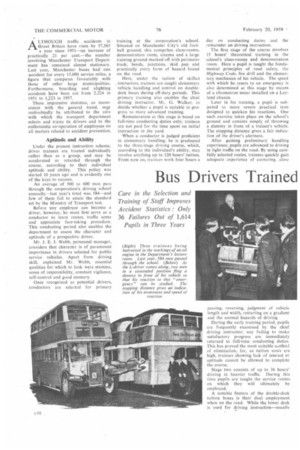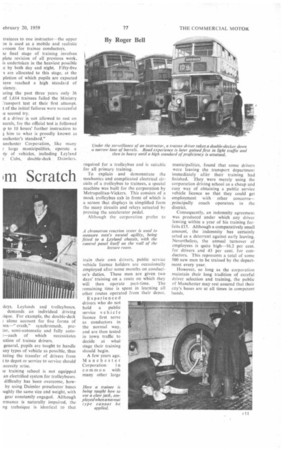Bus Drivers Trained urn Scratch
Page 46

Page 47

If you've noticed an error in this article please click here to report it so we can fix it.
By Roger Bell
Care in the Selection and Training of Staff Improves Accident Statistics : Only 36 Failures Out of 1,614
Pupils in Three Years
ALTHOUGH traffic accidents in 6reat Britain have risen by 57,365 a year since 1951—an increase of practically 21 per cent.—the number involving Manchester Transport Department has remained almost stationary. Last year, Manchester buses had one accident for every 15.000 service miles, a figure that compares favourably with those of other large municipalities. Furthermore, boarding and alighting accidents have been cut from 2,224 in 1951 to 1,223 in 1957.
These impressive statistics, so inconsistent with the general trend. my undoubtedly be attributed to the care with which the transport department selects and trains its drivers and to the enthusiastic co=operation of employees on all matters related to accident prevention.
Aptitude and Ability
Under the present instruction scheme, driver trainees are treated individually rather than as a group, and may be accelerated or retarded through the course, according to their individual aptitude and ability. This policy was started 10 years ago and is evidently one of the keys to success.
An average of 500 to 600 men pass through the corporation's driving school annually—last year's total was 584—and few of them fail to attain the standard set by the Ministry of Transport test.
Before any employee can become a driver, however,•he must first serve as a conductor to learn routes, traffic sense and appreciate fare-taking procedure. This conducting period also enables the department to assess the character and aptitude of a prospective driver.
Mr. J. E. J. Webb, personnel manager, considers that character is of paramount importance in drivers selected for public service vehicles. Apart from driving skill, explained Mr. Webb, essential qualities for which to look were stamina, sense of responsibility, constant vigilance, self-control and good memory.
Once recognized as potential drivers, conductors are selected for primary training at the corporation's school. Situated on Manchester City's old football ground, this comprises class-rooms. demonstration room, cinema and a large training ground marked off with perimeter track, bends, junctions, skid pan and practically every form of hazard found on the road.
Here, under the tuition of skilled , instructors, trainees are taught elementary vehicle handling and control on doubledeck buses during off-duty periods. This primary training also enables the chief driving instructor. Mr. G. Walker, to decide whether a pupil is suitable to progress to more advanced training.
Remuneration at this stage is based on full-time conducting duties only; trainees are not paid for the time spent on initial instruction in the yard.
When a conductor is judged proficient in elementary handling, he is graduated to the three-stage driving course, which, according to the individual's ability, may involve anything up to 120 hours' tuition. From now on, trainees work four hours a day on conducting duties and the remainder on driving instruction.
The first stage of the course involves 15 hours' theoretical training in the school's class-rooms and demonstration room. Here a pupil is taught the fundamental principles of road safety, the Highway Code, fire drill and the elementary mechanics of his vehicle. The speed with which he reacts to an emergency is also determined at this stage by means of a chronotron tester installed on a Leyland chassis.
Later in his training, a pupil is subjected to more severe practical tests designed to quicken his reactions. One such exercise takes place on the school's ground and consists simply of throwing a dummy in front of a trainee's vehicle. The stopping distance gives a fair indication of the driver's alertness.
After gaining preliminary handling experience, pupils are advanced to driving in light traffic on the road. By using carefully selected routes, trainees quickly gain adequate experience of cornering, close passing, reversing, judgment of vehicle length and width, restarting on a gradient and the normal hazards of driving.
During the early training period, pupils are frequently examined by the chief driving instructor; any failing to make satisfactory progress are immediately returned to full-time conducting duties. This has proved the most suitable method of elimination, for, as tuition costs are high, trainees showing lack of interest or aptitude cannot be allowed to complete the course.
Stage two consists of up to 36 hours' driving in heavier traffic. During this time pupils are taught the service routes on which they will ultimately be employed.
A notable feature of the double-deck tuition buses is their dual employment when on the road. While the lower deck is used for driving instruction—usually
trainees to one instructor—the upper m is used as a mobile and realistic i-room for trainee conductors.
le final stage of training involves plete revision of all previous work, is undertaken in the heaviest possible Lc by both day and night. Fifty-five s are allocated to this stage, at the pletion of which pupils are expected lave reached a high standard of ciency, aring the past three years only 36 of 1,614 trainees failed the Ministry 7ransport test at their first attempt.
t of the initial failures were successful Le second try.
it a driver is not allowed to rest on aurels, for the official test is followed ip to 10 hours' further instruction to
• .g him to what is proudly known as mchester's standard."
anehester Corporation, like many r large municipalities, operate a ty of vehicles, including Leyland r Cubs, double-deck Daimlers, ;leys, Leylands and trolleybuses.
demands an individual driving ;ique, For example, the double-deck ; alone account for five forms of mx—" crash," synchromesh, pretor, semi-automatic and fully auto:--each of which necessitates action of trainee drivers.
general, pupils are taught to handle any types of vehicle as possible, thus tatting the transfer of drivers from Ito depot or service to service should lecessity arise.
le training school is not equipped an electrified system for trolleybuses. difficulty has been overcome, howby using Daimler preselect or buses iughly the same size and weight, with gear constantly engaged. Although wmance is naturally impaired, the ng technique is identical to that required for a trolleybus and is suitable for all primary training.
To explain and demonstrate the mechanics and complicated electrical circuits of a trolleybus to trainees, a special machine was built for the corporation by Metropolitan-Vickers. This consists of .a mock trolleybus cab in front of which is a screen that displays in simplified form the many circuits and relays actuated by pressing the accelerator pedal.
Although the corporation prefer to train their own drivers, public service vehicle licence holders are occasionally employed after some months on conductor's duties. These men are given two days training on a route on which they will then operate part-time. The remaining time is spent in learning all other routes operated from their depot.
Experienced drivers who do not hold a public service vehicle licence first serve as conductors in the normal way, and are then tested in town traffic to decide at what stage their training should begin.
A few years ago. Manchester Corporation i n Common with many other large municipalities, found that some drivers were leaving the transport department immediately all& their training had finished. They were merely using the corporation driving school as a cheap and easy way of obtaining a public service vehicle licence so that they could get employment with other concerns— principally coach operators in the district.
Consequently, an indemnity agreement was produced under which any driver leaving within a year of his training forfeits £15. Although a comparatively small amount, the indemnity has certainly acted as a deterrent against early leaving. Nevertheless, the annual turnover of employees is quite high-16.2 per cent. for drivers and 43 per cent, for conductors. This represents a total of some 500 new men to be trained by the department every year.
However, so long as the corporation maintain their long tradition of careful driver selection and training, the public of Manchester may rest assured that their city's buses are at all times in competent hands.








































































































